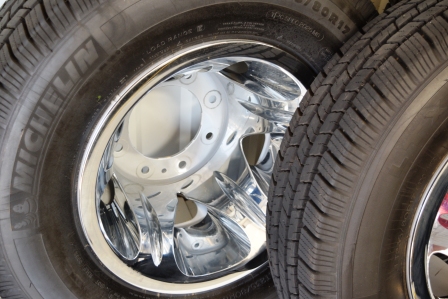18 inch DIAMO 8 Karat Black Wheels Rims 8x170 10 Ford F250 F350
16 Inch Alcoa Dually Wheels - One of the wheels is known as a circular component that is supposed to rotate for an axle bearing. The wheel is one of the main the different parts of the wheel and axle which is about the six simple machines. Wheels, side by side with axles, allow heavy objects to remain moved easily facilitating movement or transportation while supporting lots, or performing labor in machines. Wheels are used in other purposes, perhaps a ship's wheel, steering wheel, potter's wheel and flywheel.Common examples you find in transport applications. One of the wheels greatly reduces friction by facilitating motion by rolling together fx axles. In order for wheels to rotate, a moment would need to apply to the wheel about its axis, either because of gravity or by using another external force or torque.The English word wheel arises from the Old English word hweol, hweogol, from Proto-Germanic *hwehwlan, *hwegwlan, from Proto-Indo-European *kwekwlo-, a good style of the cause *kwel- "to revolve, move about ".Cognates within Indo-European include Icelandic hjól "wheel, tyre", Greek κύκλος kúklos, and Sanskrit chakra, aforementioned both meaning "circle" or "wheel ".Precursors of wheels, known as "tournettes" or "slow wheels", were known with the Middle East through the 5th millennium BCE (one of the earliest examples was discovered at Tepe Pardis, Iran, and dated to 5200–4700 BCE). We were holding fabricated from stone or clay and secured to the floor with a peg inside center, but required effort to turn. True (freely-spinning) potter's wheels were apparently being used in Mesopotamia by 3500 BCE even since 4000 BCE, and therefore the oldest surviving example, that's associated with Ur (modern day Iraq), dates to approximately 3100 BCE.The 1st proof of wheeled vehicles appears on the last half on the 4th millennium BCE, near-simultaneously in Mesopotamia (Sumerian civilization), the Northern Caucasus (Maykop culture) and Central Europe (Cucuteni-Trypillian culture), so that the question which culture originally invented the wheeled vehicle holds unsolved.The primary well-dated depiction associated with a wheeled vehicle (here a wagon — four wheels, two axles) is for the Bronocice pot, a c. 3500 – 3350 BCE clay pot excavated during a Funnelbeaker culture settlement in southern Poland.The oldest securely dated real wheel-axle combination, that from Stare Gmajne near Ljubljana in Slovenia (Ljubljana Marshes Wooden Wheel) is now dated in 2σ-limits to 3340–3030 BCE, the axle to 3360–3045 BCE.2 kinds of early Neolithic European wheel and axle are known; a circumalpine variety of wagon construction (the wheel and axle rotate together, like in Ljubljana Marshes Wheel), and that also within the Baden culture in Hungary (axle would not rotate). They are dated to c. 3200–3000 BCE.In China, the wheel was certainly present using the adoption of this chariot in c. 1200 BCE,although Barbieri-Low[9] argues for earlier Chinese wheeled vehicles, c. 2000 BC.
Related Images with 18 inch DIAMO 8 Karat Black Wheels Rims 8x170 10 Ford F250 F350
16 Rims 8 Lug http://www.ebay.com/itm/16inchBlackWheelsRimsFORD
1994 Ford F350 XLT 4x4 diesel crew cab with plow $4900 batavia

Dually Wheel Simulators 17 Inch 2017 2018 Best Cars Reviews

2014 Ram Dually Truck Stock Rims Front And Back; Also Chrome Covers
| TITLE: | 18 inch DIAMO 8 Karat Black Wheels Rims 8x170 10 Ford F250 F350 |
| IMAGE URL: | http://img0105.popscreencdn.com/161466649_18-inch-diamo-8-karat-black-wheels-rims-8x170-10-ford-.jpg |
| THUMBNAIL: | https://tse1.mm.bing.net/th?id=OIP.Omc4ar1ImVzHo9d7CYHCLgEsEU&pid=Api&w=195&h=181 |
| IMAGE SIZE: | 22273 B Bs |
| IMAGE WIDTH: | 320 |
| IMAGE HEIGHT: | 295 |
| DOCUMENT ID: | OIP.Omc4ar1ImVzHo9d7CYHCLgEsEU |
| MEDIA ID: | B562C33517D2685CD01640B80FD6CAF7258ECEFC |
| SOURCE DOMAIN: | autospost.com |
| SOURCE URL: | http://www.autospost.com/cat/1996-f250-alcoa-wheel.html |
| THUMBNAIL WIDTH: | 195 |
| THUMBNAIL HEIGHT: | 181 |
Related Images with 18 inch DIAMO 8 Karat Black Wheels Rims 8x170 10 Ford F250 F350
16 Rims 8 Lug http://www.ebay.com/itm/16inchBlackWheelsRimsFORD
1994 Ford F350 XLT 4x4 diesel crew cab with plow $4900 batavia

Dually Wheel Simulators 17 Inch 2017 2018 Best Cars Reviews

Komentar
Posting Komentar